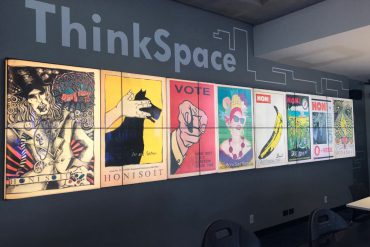A commitment to transformational learning is what unites our efforts and orients our actions. For some this may involve finding ways to foster a sense of belonging in students within a unit, program or degree. For others it may involve reimagining assessments to more accurately reflect student learning. But all this thoughtful action takes place somewhere and this begs the question,
How does a single learning space or an entire campus support a transformational education?
To respond, we need to be able to say something about the relationship between educational strategy and educational infrastructure, and clearly articulated values and shared language about anticipated use are helpful in this regard. This post offers an introduction to the principles guiding the (re)development of learning spaces at Sydney that were developed in consultation with faculty and students through the Learning Environments Planning Committee (LEPC) and have recently been endorsed by UE (Education). The second post in this series introduces images intended to support conversations between educators and those responsible for the design and maintenance of educational infrastructure. Future posts will explore the remaining principles using current examples of how they are helping to shape the spaces in which we teach and learn.
Orienting our actions: from initial concept to final design
 Image source: HDR Inc.
Image source: HDR Inc.
Principle 1: Take an activity-centred approach
Learning is at the heart of all we do and is contingent on what students actually do, or their learning activity. We aim to ensure our students have access to spaces that support opportunities for them to engage with a broad range of ideas, objects and people, demonstrate and share their work, and reflect on their learning.
We acknowledge that learning is not always formal and student interaction around shared interests supports community development and a sense of belonging. We aim to develop a network of interstitial spaces to accommodate a defined but diverse range of co- and extra-curricular activity.
Not taking an activity centred approach leaves us with a partial view of our students needs and diminishes our capacity to provide fair access to appropriate spaces for all.
Principle 2: Specify and accommodate valued task types
Instructional designs (tasks) take many forms. We aim to offer our students an appropriate balance of directed, exploratory, productive, and reflective learning because this mix supports increasing student autonomy and task complexity.
Our aim is to ensure staff are confident that instructional designs based on these task types will be suitably accommodated in formal teaching spaces, and that their students will have access to spaces designed to support self-directed tasks and a range of complementary co- and extra-curricular activity.
Not specifying a range of valued task types increases the likelihood of misalignment between instructional and architectural design and produces unnecessary variation in design that is difficult to manage and maintain at scale.
Principle 3: Connect learning across time and space
Learning spans both time and place. We will design and maintain complementary physical and digital infrastructure for learning, with the aim of connecting people, ideas, and resources across multiple time/space contexts.
Students will have access to appropriate learning and support services on campus and online, with the aim of connecting directed, self-directed, and immersive learning experiences. In addition, we acknowledge and aim to support a broader range of social needs.
Doing this well will involve careful consideration of permeable boundaries, functional zones of transition, physical and digital intersections and overlays, and detailed planning with regards to navigation and wayfinding—both on campus and online.
Not intentionally designing connections across time and space can result in missed opportunities to support learning, leaves students to find adequate space to do what is necessary between formal classes and puts those with long commutes and work or caring commitments at a disadvantage.
Principle 4: Support sustainable teaching practices and environments
We will design learning spaces to support sustainable evidence informed teaching practices, and not trends in technology or policy.
We will establish a defined suite of learning spaces capable of accommodating valued task types (directed, exploratory, productive, and reflective learning), with the aim of reliably supporting staff to develop and extend their teaching repertoires. Each space type will support a specific set of pedagogical suitabilities, through a defined range of fittings, furnishing, and equipment. Designs with high internal variation in the form of mobile furnishings will be minimised and, where feasible, central storage will be considered for physical learning resources. We will embrace long-term iterative innovation over bespoke serial interventions.
Not designing to support sustainable practices and environments results in task designs that are space agnostic (i.e., more talking, less doing), in-class time used to prepare for common (valued) task types, increased refresh rates for mobile furnishings and equipment, and underutilised bespoke spaces.
Principle 5: Draw on local knowledge and learn from what we do
We will be curious about our students’ learning needs, the intricacies of valued teaching practices, the real complexity of orchestrating student-led learning, and the challenges associated with managing space that accommodates all of this well. This will require honest engagement from all stakeholders when (re)designing space or space related policy for learning.
We will explore critical challenges with respect to teaching and learning, work with innovative practitioners to resolve them, and commit to hearing from and understanding the disaffected. Together we will raise the standard of learning space provision by building on our strengths and learning from our past.
Not drawing on local knowledge or learning from what we do risks repeating failed designs or the serious misalignment of learning needs and spatial provisions, not to mention missed opportunities for community building and both individual and organisational learning.
Principle 6: Allow space for meaningful co-creation and local variation
Learning emerges out of shared knowledge-oriented activity. A well-appointed environment for learning encourages student-led exploration and the re-configuration of space and tools for learning.
Our suite of space types will be thought of as finished beginnings, not final products. Each base-design will intentionally invite a degree of co-creation. We will give careful consideration to the selection of a limited number of variations, in the form of reconfigurable furnishings or low-cost consumables, for each space type and will allow for local variation by zone.
Not allowing for meaningful co-creation establishes passive rather than active norms, ignores small local variations in teaching and learning practices, and delegates responsibility for the provision of low-cost dialogic consumables to staff or students (e.g., whiteboard pens and cleaning, butchers paper, and post-It notes).
Principle 7: Prioritise the curation and care of space for learning
If we value learning activity that involves human movement in shared spaces, then we must understand the need for curators and caretakers of space.
We commit to developing a network of local curators and/or custodians of space and will respect the need for and people who maintain our spaces daily.
We will actively support the sharing of learning space related knowledge and practices. This will involve training for student peer learning advisors, and teaching, learning support and operational staff, as well.
Not prioritising the curation and care of space for learning results in overly deterministic assumptions about the role of space in learning, and devalues the skill involved in orchestrating and managing space that accommodates valued learning activity well.





